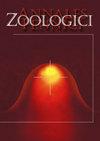Multi-Locus Genetic Identification of a Newly Discovered Population Reveals a Deep Genetic Divergence in European Blind Mole Rats (Rodentia: Spalacidae: Nannospalax)
IF 0.9
4区 生物学
Q4 ECOLOGY
引用次数: 7
Abstract
A new population of blind mole rat (genus Nannospalax) was discovered near the town of Albertirsa in north-central Hungary. We used newly designed primers to specifically amplify the whole mitochondrial cytochrome-b region and two nuclear DNA regions. Based on the most comprehensive taxonomic sampling to date, we compared this population with several other European blind mole-rat taxa. The results from both mitochondrial and nuclear regions have unequivocally placed the Albertirsa population into the monophyletic group of the Vojvodina blind mole rat (N. (leucodon) montanosyrmiensis), which turned out to be a sister clade to all other molecularly studied European Nannospalax. This study not only identified the fourth known population of an extremely rare rodent taxon but also calls for a taxonomic revision of European lesser blind mole rats (N. leucodon superspecies) to systematically evaluate the genetic structure of their populations and to understand the complex evolutionary history of these European rodents. The occurrence of the Vojvodina blind mole rat at this northern location helps to clarify the distribution area of this heavily data-deficient taxon. As currently understood, this lineage predominantly occurs in sandy grasslands of the Danube–Tisza Interfluve in Hungary and Serbia. Its distribution range and phylogenetic structure might reflect the importance of potential biogeographical barriers (e.g. large rivers) that shaped the blind mole rats' allopatric or peripatric speciation.一个新种群的多位点遗传鉴定揭示了欧洲盲鼹鼠的深度遗传分化(啮齿目:斑齿科:斑齿目)
在匈牙利中北部的Albertirsa镇附近发现了一个新的盲鼹鼠(Nannospalax属)种群。我们使用新设计的引物特异性扩增整个线粒体细胞色素-b区域和两个核DNA区域。基于迄今为止最全面的分类抽样,我们将这个种群与其他几个欧洲盲鼹鼠分类群进行了比较。线粒体和细胞核区域的结果明确地将Albertirsa种群置于伏伊伏丁那盲鼹鼠(N. (leucodon) montanosymiensis)的单系群中,这是所有其他分子研究的欧洲Nannospalax的姐妹分支。本研究不仅发现了已知的第四个极为罕见的啮齿动物类群,而且还呼吁对欧洲小盲鼹鼠(N. leucodon超种)的分类进行修订,以系统地评估其种群的遗传结构,并了解这些欧洲啮齿动物的复杂进化历史。伏伊伏丁那盲鼹鼠在这一北部地区的出现有助于澄清这一数据严重缺乏的分类单元的分布区域。据目前所知,这个谱系主要发生在匈牙利和塞尔维亚多瑙河- tisza交汇处的沙质草原上。其分布范围和系统发育结构可能反映了潜在的生物地理障碍(如大河)的重要性,这些障碍塑造了盲鼹鼠的异域或周边物种形成。
本文章由计算机程序翻译,如有差异,请以英文原文为准。
求助全文
约1分钟内获得全文
求助全文
来源期刊

Annales Zoologici Fennici
生物-动物学
CiteScore
2.40
自引率
14.30%
发文量
10
审稿时长
>12 weeks
期刊介绍:
Annales Zoologici Fennici publishes mainly original research reports, but also in-depth reviews and commentaries on all aspects of animal ecology and evolution, and fields related to them. Our aim is to promote papers which focus on the interactions among various components in the past and present environments by using integrative and cross-disciplinary approaches. This may be achieved by employing tools from different fields of research, such as (but not restricted to):
ecology and paleoecology,
molecular ecology and phylogeography,
conservation biology, human-induced contemporary evolution and wildlife management,
animal behaviour and interactions (including recognition systems and mechanisms),
paleontology (except systematics and taxonomy) and evolution,
bioenergetics.
 求助内容:
求助内容: 应助结果提醒方式:
应助结果提醒方式:


